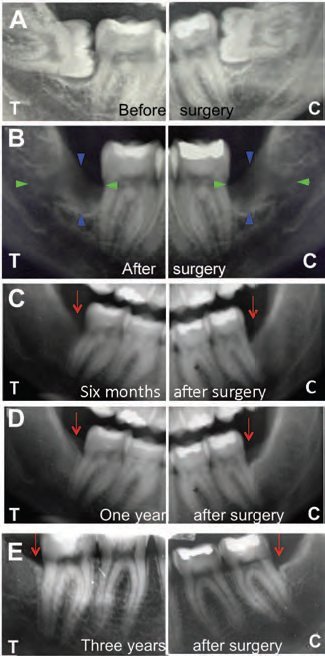Stem cells produce compact, regenerated bone in mandible transplants
Bone transplantation is a major strategy for the repair of bone defects. However, reconstruction of the mandible (jawbone) has long been a difficult challenge for oral surgeons - until now.
A study in the latest issue of STEM CELLS Translational Medicine shows how stem cells can be used to successfully repair the mandible after a molar extraction and that, years later, the new bone is still functioning properly. Interestingly, the regenerated bone is also hard, rather than the spongy kind normally found in the jaw.

The study is a follow-up to previous investigations by an international team of researchers in which they discovered that mesenchymal stem cells taken from dental pulp and seeded on a collagen scaffold successfully repaired the mandible bone. In this latest work, they checked on patients who had received the mandible bone grafts three years earlier to assess the stability and quality of the regenerated bone and vessel network.
They found the new bone had normal function and was richly vascularised, although it was much more compact than the spongy type normally found in the mandible. The team theorised that, most probably, regeneration of compact bone occurs because grafted dental-pulp stem cells do not follow the local signals of the surrounding spongy bone.
“The mandible is constructed from spongy bone on account of its role linked to the presence of teeth and their movements, so regeneration of a compact, rather than a spongy bone type, is difficult to justify physiologically. We concluded, therefore, that grafted dental pulp stem cells do not pursue the local environmental signals emanating from the alveolar bone surrounding the graft site,” said Dr Gianpaolo Papaccio of the Department of Experimental Medicine at Second University of Naples.
“This must be taken into consideration when grafting stem cells,” he continued. “Their behaviour may be quite variable and, consequently, their differentiation fate in some cases may be affected more by their specific origin than by the local signals of the treated area.
“Although the bone regenerated at the graft sites is not of the proper type found in the mandible, it does seem to have a positive clinical impact. In fact, it creates steadier mandibles, may well increase implant stability and, additionally, may improve resistance to mechanical, physical, chemical and pharmacological agents.”
Dr Papaccio led the study team that included colleagues from Second University as well as researchers from Università Politecnica delle Marche, Ancona; Université CB Lyon; European Synchrotron Radiation Facility, Grenoble; and the University of Michigan.
Dr Anthony Atala, Editor of STEM CELLS Translational Medicine and Director of the Wake Forest Institute for Regenerative Medicine, commented, “Dental pulp is an interesting source of ready-to-use stem cells to treat bone defects. The finding that these cells regenerate compact bone in the mandible indicates a potential role in the treatment of oral cancer.”
Blood test could be used to diagnose Parkinson's earlier
Researchers have developed a new method that requires only a blood draw, offering a non-invasive...
Cord blood test could predict a baby's risk of type 2 diabetes
By analysing the DNA in cord blood from babies born to mothers with gestational diabetes,...
DNA analysis device built with a basic 3D printer
The Do-It-Yourself Nucleic Acid Fluorometer, or DIYNAFLUOR, is a portable device that measures...





